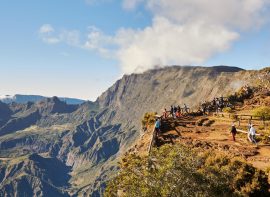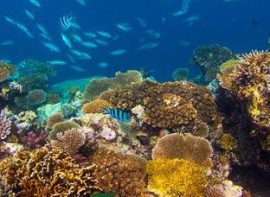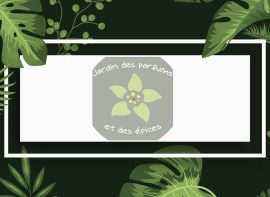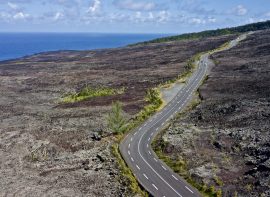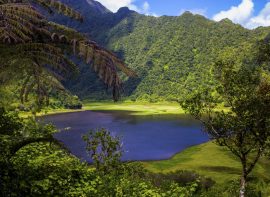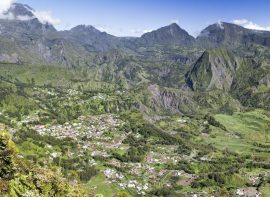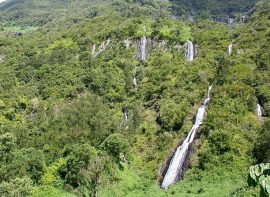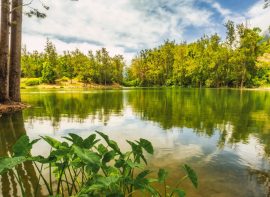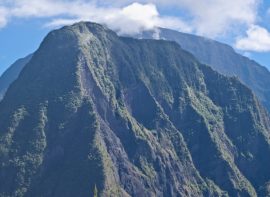
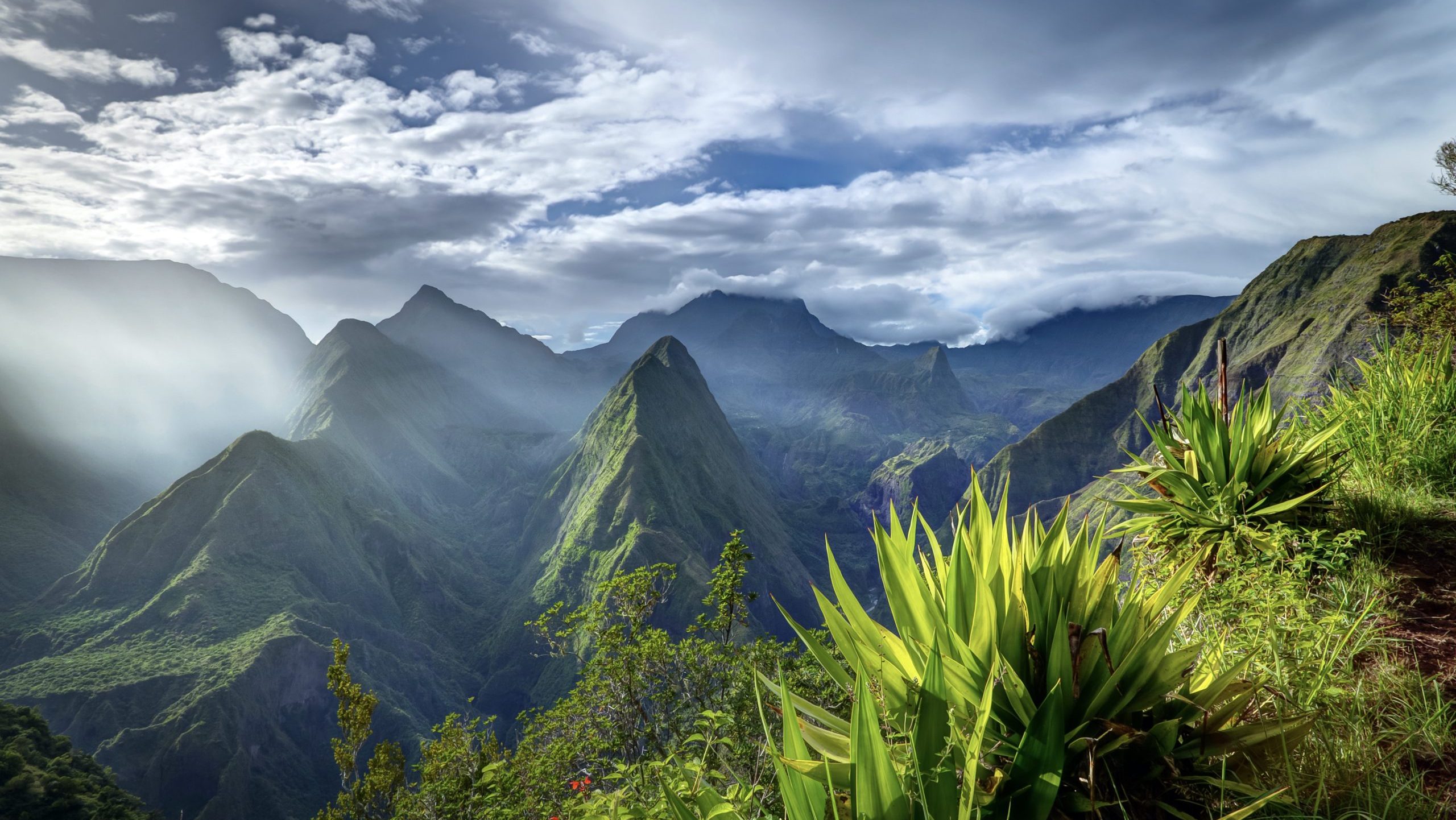
Mafate is located in the central zone of the Parc national de La Réunion. It is also part of the UNESCO World Heritage Site of the Pitons, Cirques and Remparts of Reunion Island, which was designated a World Heritage Site in 2010.
Mafate, the mythical cirque that lives outside time. No roads, no cars, welcome to the end of the world… A lost and isolated paradise in the heart of the island, Mafate has to be earned, but offers its visitors breathtaking scenery and a simple, authentic life in communion with nature, far removed from modern civilization, its consumer society and its race against time.
History of the Cirque of Mafate
Mafate is one of the three great natural cirques of the Piton des Neiges massif. The cirque was formed by a combination of tectonic collapse and torrential erosion, creating a particularly steep and chaotic relief and forming the watershed of the Rivière des Galets. The cirque is encircled by ten peaks over 2,000 meters high! There are no roads into the cirque, so access is only possible via footpaths.
The cirque of Mafate is intimately linked with marronage. During the period of slavery on Reunion Island, many slaves fled to the mountains to regain their freedom. Reunion’s cirques, with their immense ramparts and very difficult access, provided the maroon slaves with a place to hide and live. The name given to the cirque “Mafate” is said to come from a chief maroon slave of Malagasy origin who made the cirque his home. The word Mafate comes from the Malagasy “Mahafaty”, meaning “who kills, dangerous”.
Some inhabitants of the ilets are direct descendants of these maroon slaves, who were joined by the “petits blancs des hauts” or “Yabs”. These destitute agricultural workers, deprived of land due to demographic development, inheritance rules and the abolition of slavery, preferred to settle in the highlands and sometimes in the cirques of the island in search of fertile land. Today, the Mafate cirque and its 700 inhabitants remain steeped in these origins. It still intrinsically bears the values of freedom and the fight against oppression.
Today, the Mafate cirque straddles the territories of the communes of Saint-Paul and La Possession. Its inhabitants, the Mafatais, occupy and cultivate a number of islets.
What is an islet?

The îlets (pronounced “ilettes”) are small isolated hamlets made up of a few tin huts (houses) on arable plateaus.
Mafate has 10 main islets:
- La Nouvelle is the most densely populated islet, and is considered the capital of the cirque, as well as being the easiest to access.
- Marla is the southernmost islet, at an altitude of over 1,600 meters.
- Aurère, to the north of the cirque, is an islet accessible from the Rivière des Galets to the west, or from the Salazie cirque via the Scout trail.
- Îlet à Bourses and îlet à Malheur are two small islets not far from Aurère.
- The islets of Cayenne and Grand Place are located in the center of the cirque, linking the different areas of the cirque.
- The islets of Les Orangers and Les Lataniers lie to the west of the cirque, and can be reached from the Orangers channel or from the Piton Maïdo.
- Roche Plate, a small islet, lies below the rampart of the Piton Maïdo.
Life in Mafate

Mafate’s isolation, far from road communication routes, imposes a specific way of life and organization. As a result, Mafate has a dense network of trails (over 140 kms) that make living in the cirque possible.
In the past, the ilets were supplied by men and women, or by oxen (as evidenced by several place names, such as Col des Bœufs).
Today, supplies are provided by helicopter. Each islet has its own landing platform. This means that food and material supplies, medical aid and waste disposal are all carried out by air. Hikers are therefore strongly advised to take their garbage with them. On the other hand, the letter carrier’s rounds for mail delivery are still carried out on foot.
Schooling is provided up to the end of elementary school in eight schools, generally with a single class, spread across the various islets. From middle school onwards, pupils must go to schools on the coast, where they stay with host families or in boarding schools.
Electricity is supplied by individual photovoltaic systems and generators. For telecommunications and internet, the cirque is served by the 4G network.
Water is collected from various springs and streams to supply the islets and homes with running water.
The economy is essentially based on tourism and welcoming hikers. There are almost fifty stopover gîtes in the cirque.
Most of the inhabitants live on a mixed subsistence diet, some almost self-sufficiently: they keep animals (livestock, hens), cultivate vegetable gardens and plant orchards.
The little story… of the postman of Mafate
Angelo Thiburce, Ivrin Pausé, you may not know their names, but all the inhabitants of Mafate do! They’re letter carriers. They are legends who have criss-crossed the cirque for 40 years, delivering letters and parcels. For the inhabitants of the Mafate cirque, the letter carrier symbolizes the link with the outside world. If you’re passing through Grand-Place, you can see the statue of Ivrin Pausé, nicknamed “the letter carrier in slippers”, who worked as a letter carrier in Mafate from 1951 to 1991. He was born here in 1928. Covering more than 250,000 km, or 6 times around the world, he carried more than 30 tons of letters on his back for the people of Mafate. A song to his glory was even written, “Le Facteur De Mafate” by Bat’ker.
Access to Mafate

Due to the particularly rugged terrain, entry points into the Mafate cirque are limited. It is therefore possible to access it on foot:
- From the cirque de Cilaos, over the Col du Taïbit to Marla ;
- From the Salazie cirque via Col des Bœufs, Col de Fourche to La Nouvelle, or via Bord Martin to Îlet à Malheur;
- From the west coast, via the Rivière des Galets or Dos d’Âne to Deux Bras,
- Via the heights of Sans Souci and the Orangers canalization to Îlet des Orangers and Lataniers ;
- From the Piton Maïdo, towards Roche Plate.
Hiking ideas
The cirque de Mafate is a hiking paradise. The trails are well-marked and well-maintained. You need to prepare your outing carefully (weather, equipment, itinerary, etc.) just as you would for a hike in the Pyrenees or the Alps, as changes in altitude or weather conditions can make your discovery more complicated.
Here are two ideas for multi-day tours of the cirque. There are many possible itineraries. We present here two itineraries which are also complementary and which, in just a few days, will give you an idea of the richness and beauty of the landscapes of this unique cirque.
Excursions to Mafate
Before joining the cirque
Bring water, sun cream, a hat, good shoes and warm clothing, and an IGN 1:25000 map, number 4402RT.
Find out about trail conditions and any closures in case of bad weather on the Office National des Forêts website.
There are no ATMs on Mafate, so you’ll need to bring cash for grocery stores and gîtes.
For camping enthusiasts, it’s possible to pitch a tent at a gîteur’s who offers a piece of grassy ground. Bivouacs are permitted as long as people respect the environment. As the cirque de Mafate is part of the “inhabited heart” of the Parc national de La Réunion, the park’s rules apply.
As for gîtes, bookings must be made in advance, as must half-board meals. Most welcome guests from 3pm. You should expect to pay around €20 for a bed, €20 for dinner and €8 for breakfast.
Taxi information
If you wish to reach the cirque de Mafate from the Rivière des Galets (La Possession commune), you can leave your vehicle at the end of the track that runs into the riverbed. The parking lot is supervised and free of charge during the day. From here, pick-up cabs will take you along the riverbed to a place called “Deux Bras”. This is where the trail along the river begins. Cabs must be booked in advance for both outward and return journeys.
Preserving Mother Nature
The Mafate cirque is an exceptional place that deserves to be discovered! This extraordinarily well-preserved site offers many breathtakingly beautiful landscapes in the heart of the UNESCO World Heritage Site. To ensure the preservation of the cirque, its inhabitants and its culture, particular attention is paid to developing sustainable and responsible tourism practices. Clean energy, waste management, limiting environmental pollution, preserving biodiversity, local production and consumption, disconnection and sharing make the Mafate cirque an example of ecotourism.
Before setting off to hike in the fabulous Mafate cirque, here are six golden rules to help you adopt the Mafate Attitude, be a responsible hiker and experience 100% of the Mafate adventure (recommendations issued by Ile de La Réunion Tourisme):
1 – THOU SHALT EAT LOCALLY
No need to load up on drinks, snacks for the evening or sandwiches for the return trip, just buy them in the small grocery stores on the various islets. They’ll be lighter to carry and will help the circus economy.
2 – WITH YOUR WASTE YOU’LL GO HOME
Take a rubbish bag and dispose of it on your return to the coast. This will allow you to dispose of your garbage and/or the garbage that unfortunately litters the paths. On Mafate, garbage is hauled away by helicopter, so save the Mafatais this extra cost.
3 – LISTEN TO AND RESPECT NATURE
We haven’t invented anything better! Your state-of-the-art bluetooth speaker, which you’ll need to keep switched off so as not to disturb hikers, and so that you can listen quietly to birdsong and the wind in the bamboo.
4 – YOU WON’T MAKE A CIRCUS OUT OF MAFATE
Respect the privacy of Mafatais. Some houses have no fences, so avoid walking in their gardens. Be curious but not intrusive. If you want to take photos, ask the locals for permission.
5 – DISCONNECT YOU MUST
Recharge your batteries, get into the Maroon spirit, the free spirit!
6 – YOU WILL MEET AND EXCHANGE IDEAS
Mafate means conviviality between hikers over a drink at the bar on the islet for an “after walk” and with the Mafatais, over a good curry at the gîte.
